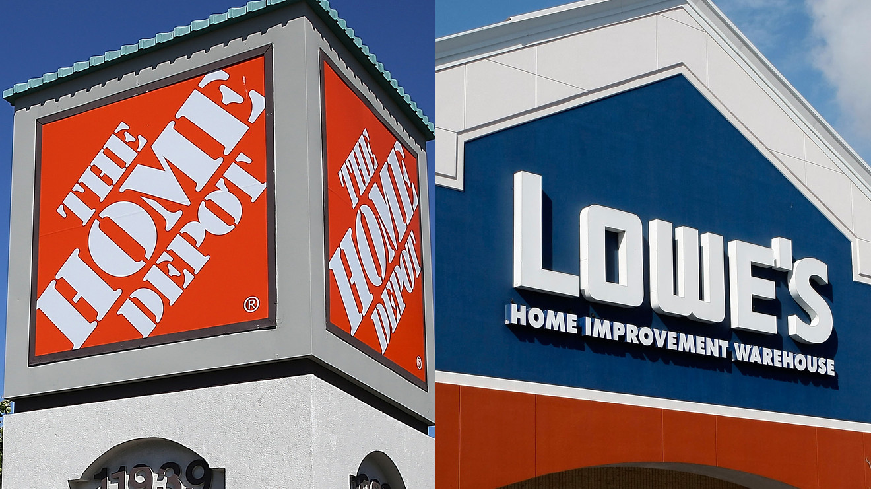As COVID-19 has forced a large portion of the population to shelter-in-place or work from home, many people are spending more time staring at their four walls with dreams of making them — and everything within them — more beautiful and functional.
Since April, when most states began taking targeted measures to contain the pandemic, home improvement sales have surged. Houzz, an online home remodeling platform, recently reported a 58 percent annual increase in project leads for home professionals when compared to June of last year. There have also been historic runs on laptop computers and desk equipment, suggesting that many families are digging in and preparing their homes to function as living spaces, workplaces, education centers, and everything in between.
For many small and medium home improvement projects, The Home Depot and Lowe’s stores are where the majority of remodelers purchase the wood, nails, bricks, and mortar to get things done. For that reason, the quarterly earnings report for the number one and two home improvement superstores are a bellwether for the greater construction economy. While the earnings for both companies continue to soar, Lowe’s recently bested The Home Depot in quarterly earnings. Regardless of who is winning the earnings race at the moment, one thing is clear: more consumers than ever before are focusing on home improvements.
Here’s some evidence that the home improvement surge spurred by the pandemic may very well last beyond the current crisis.
The Home Depot and Lowe’s both smash Q2 earnings
The Home Depot recently reported that earnings for the fiscal second quarter ending on August 2 were up 26.8 percent from the same period last year and solidly ahead of Wall Street predictions. Company revenues rose 24.75 percent to $38.1 billion, beating analysts’ projections of $34.5 billion. The Home Depot also reported that same-store sales rose 23.4 percent — more than double analysts’ forecasts of a 10.5 percent gain. Executive Vice President of Merchandising Ted Decker said in a recent earnings call that, “During the second quarter, big-ticket comp transactions, or those over $1,000, were up approximately 16 percent,” with “strong performance across a number of big-ticket categories like appliances, riding lawn mowers and patio furniture.”
Lowe’s just reported that its profits soared 68.7 percent to $2.83 billion, or $3.74 per share, up from $1.68 billion, or $2.14 per share, a year earlier — even as it spent $460 million during the first quarter on community initiatives, higher pay for hourly workers, and improvements to keep employees safe at work during the pandemic. It also will pay out a record quarterly bonus of $107 million to employees at all store locations for exceeding its financial targets. Lowe’s reported a year-to-year second-quarter earnings increase of 30 percent, largely due to a successful boost in online sales, which rose 135 percent from last year.
As Lowe’s CEO Marvin Ellison told CNBC, Lowes and other home improvement retailers are benefiting from, “a wallet-share shift away from vacations, away from dining out, away from apparel purchases.” He further added, “We’ve got tons of anecdotal information where someone was planning to take a vacation and now they’ve decided to remodel the kitchen, where they were planning to take a vacation and they decided to remodel their entire backyard to make it a place where they could spend more time.”
Lowe’s is gaining steam on The Home Depot
While The Home Depot far exceeds Lowe’s in annual earnings, the punchy challenger was able to edge past its biggest rival in quarterly same-store sales — Lowe’s biggest quarterly earnings increase in a decade. It’s one thing to say that people are spending more on home improvement during the COVID-19 lockdown, but the fact that Lowe’s was able to push past an established market leader means the market for home improvement has expanded (i.e., more consumers are participating in the space).
Many people who can are fleeing densely populated cities and heading to more suburban and rural areas for greater safety from COVID-19, lower mortgages, and more space. With more companies allowing people to work from home, the advantages of living in highly populated city center are growing fewer. As more people flock to the suburbs, home improvement sales are likely to increase.
Home improvement segment well-positioned for continued growth
Many Americans, according to the Wall Street Journal, have resorted to “painting, building, fixing and decorating,” since stay-at-home orders went into place for most of the country. Daily foot traffic at The Home Depot has soared by at least 35 percent since April. Companies specializing in swimming pools, outdoor living, and home renovations are also booming. Pool demand is so strong that even Wall Street investors are taking note. Poolcorp, an international distributor of swimming pool supplies, parts and outdoor living products, is up 54 percent in sales since last August and is on pace for its stock price to exceed its 2003 high.
The economic crisis that has cost tens of millions of workers their jobs is playing out next to the fact that many Americans are realizing the permanent benefits of making their indoor and outdoor spaces more functional and enjoyable. For many families, home improvement is not just retail therapy in the midst of a pandemic, but a long-term plan to support the mental health and well-being of their families.
The remarkable earnings by Home Depot and Lowe’s are the opening volley in a trend that is likely to continue. If home improvement retailers can make such impressive gains during the midst of a pandemic, building product brands are well-positioned to make even greater profits once COVID-19 is behind us.
For more insights, email Steve Kleber at sk@kleberandassociates.com.




